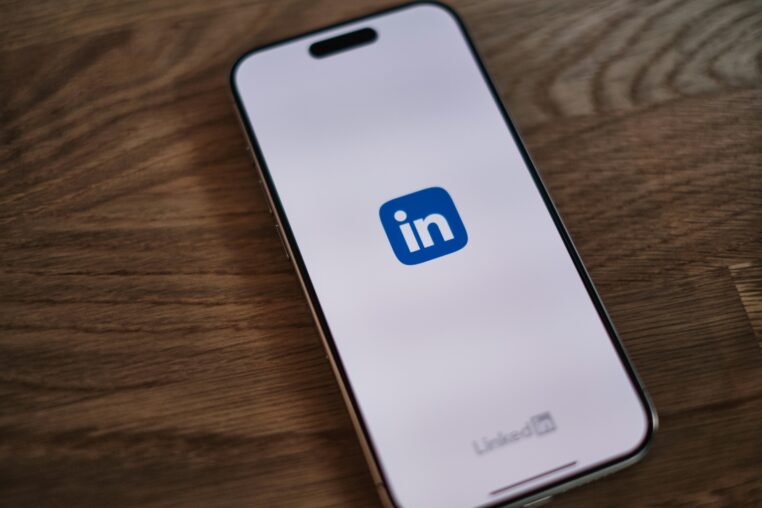How to Use LinkedIn Posts to Share Your Journey & Attract Offers
Is your LinkedIn just a digital graveyard for outdated resumes? Think again. In 2025, LinkedIn posts to share your journey and attract offers aren’t just a fancy buzzword; they’re the actual engine driving career breakthroughs. The truth is that whether you are comfortable in your present position or trying to find the next opportunity, recruiters don’t spend much time reviewing your monotonous resume; instead, they spend much of their time looking for people who regularly post valuable content. By crafting authentic posts that tell your professional story, share your wins, highlight your pivots, and convey the lessons you’ve learned, you transform yourself from invisible to irresistible. I have written this guide to walk you through exactly how to use LinkedIn posts to share your journey and attract offers, from setting up your profile like a pro to crafting posts that make recruiters actually click on your profile and reach out.
It’s not about being perfect; it’s about being real.
Key Takeaways
- Your LinkedIn profile visibility depends heavily on consistent, authentic storytelling, not polished corporate speak.
- The foundation is setting up your LinkedIn account properly; optimization is where the real magic happens.
- LinkedIn’s algorithm in 2025 rewards expertise and valuable content 2.3x more than generic posts (A generic post is a piece of content that is nonspecific, lacks unique details, and could apply to many people or situations, making it less impactful. It often employs broad, formulaic language, common phrases, and a lack of personal perspective, which can result in low engagement.)
- Posts written as stories receive 22 times more engagement than purely informational content.
- The “Open to Work” feature, combined with strategic content creation, dramatically increases a recruiter’s interest.
- Recruiters actively search LinkedIn’s content and profiles. Making you visible is a deliberate, strategic process.
- Engaging authentically with your network creates warm pathways to opportunities before they’re publicly advertised
Setting Up Your LinkedIn Account: The Foundation for Success
Alright, so you want to start using LinkedIn posts to share your journey and attract offers. But please hold on; before you start your first post, do you need a solid foundation? I’ve seen countless professionals jump straight into posting without properly setting up their profiles, and honestly, it’s like building a house on sand.
Let me guide you through this step by step because getting this right makes all the difference.
Step 1: Creating Your Account
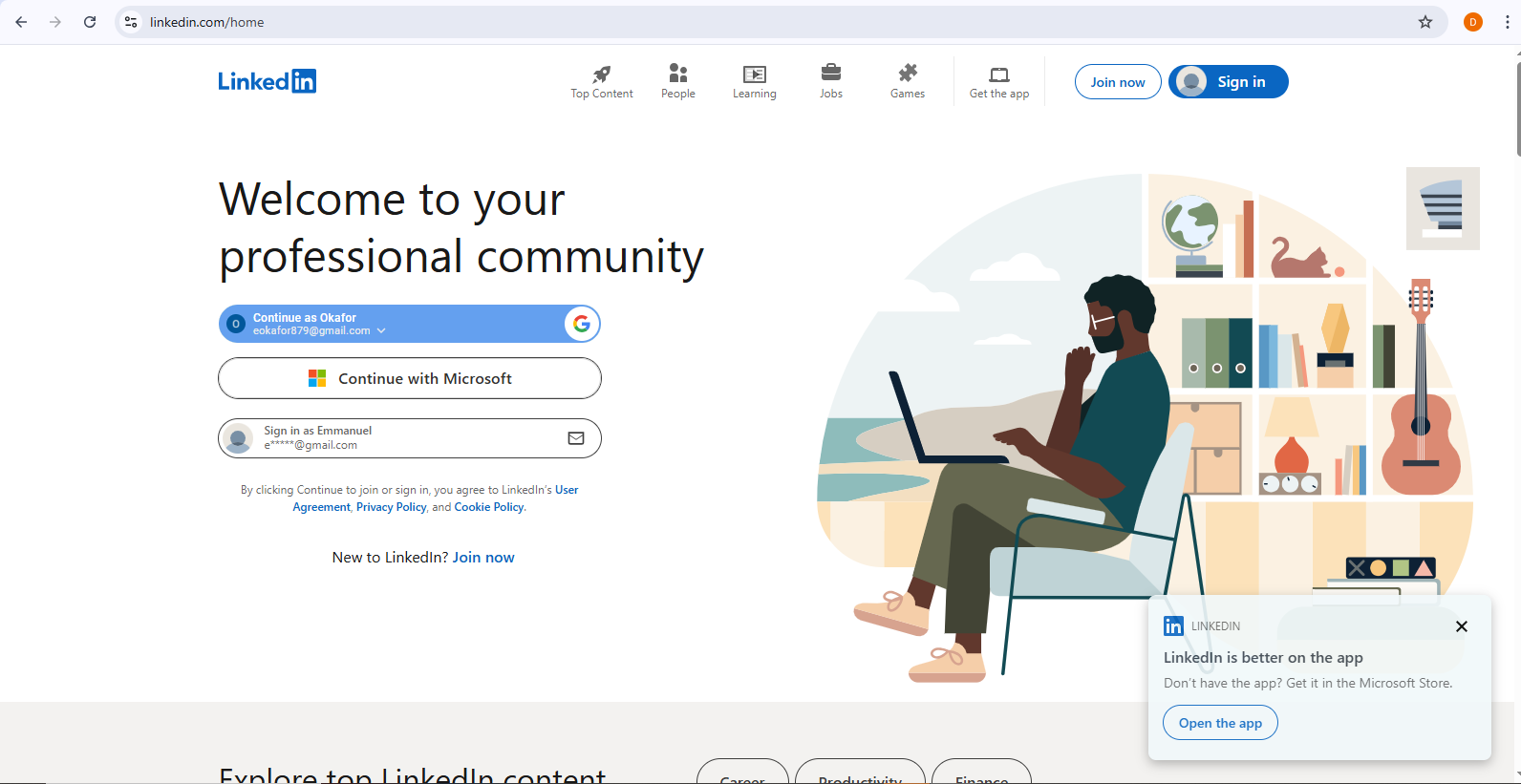
Start by heading to www.linkedin.com and clicking the “Join now” button. Here’s the critical part: use a professional email address, ideally one that includes your first name and last name, such as firstname.lastname@email.com. Why? Because it’s the first signal to recruiters that you take your professional brand seriously. You don’t want a recruiter to see an email address like this: babygirl@email.com
You can enter a strong password (Be very careful here; passwords can be tedious, but this account is too valuable to lose to a weak one), and verify your email. LinkedIn will send you a verification code. This isn’t just a formality; it’s LinkedIn’s way of ensuring account security and fully activating your profile.

Step 2: Filling in Your Core Information
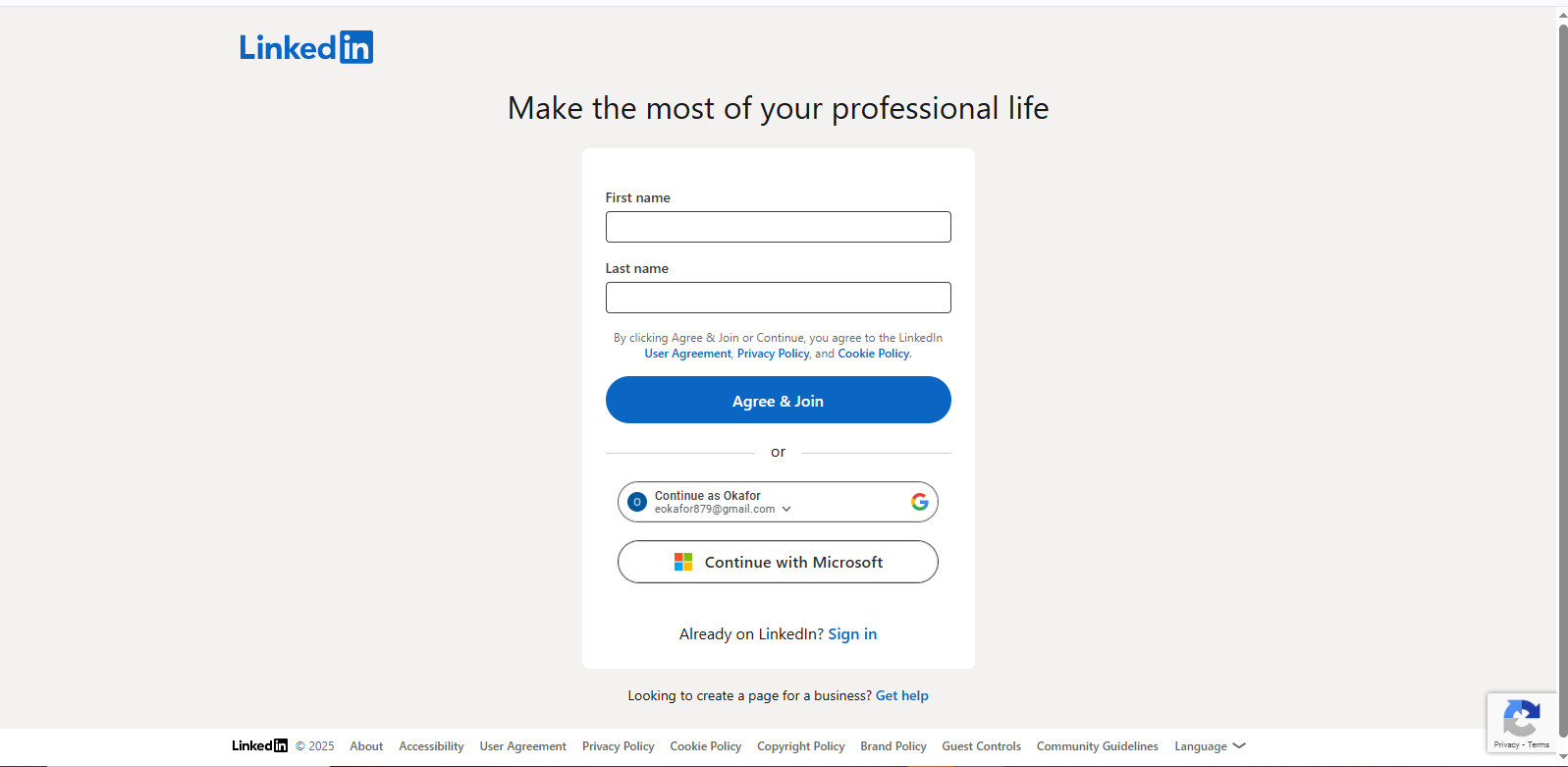
Once you’ve verified your LinkedIn account, add your location, current job title, and industry. If you are a student or in the process of switching jobs, choose that option. This data is not extra; it helps LinkedIn’s algorithm connect you with the most suitable job seekers, recruiters, and content. Your profile’s visibility begins here.
Step 3: Upload a Professional Profile Photo
Here’s something I learned from working with hundreds of professionals: a profile photo makes your LinkedIn profile 7 times more likely to be viewed. Not optional. Not nice-to-have. Essential.
Your headshot should:
- Be recent and professional (taken within the last two years)
- Have good lighting and a clean background.
- Show your face, taking up about 60% of the frame.
- Be at least 400 x 400 pixels in resolution.
- Dress how you’d dress for a meeting with a CEO
One more thing I want to share with you that I learned from my experience in tech: steer clear of pictures that are too informal. The beach selfies belong to Instagram. On LinkedIn, you are creating professional trustworthiness, and your picture is the first impression.
Step 4: Customize Your LinkedIn URL
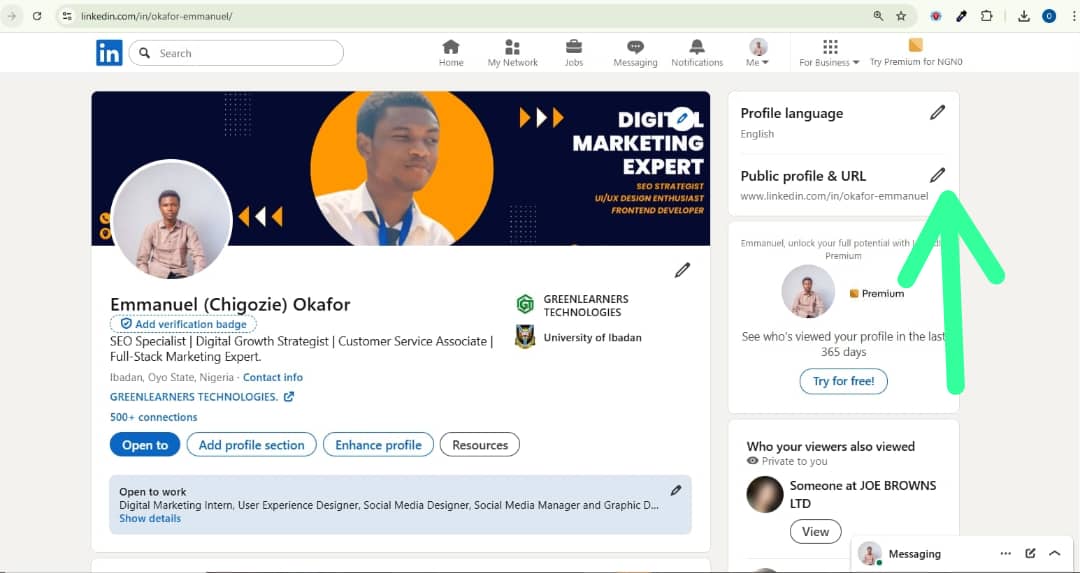
Most LinkedIn URLs are messy strings of numbers and letters. Don’t let yours be one of them. Click “Edit public profile” and customize it to link to linkedin.com/in/your name. For instance (https://www.linkedin.com/in/okafor-emmanuel/). It’s cleaner, easier to share, and signals that you’ve got your act together.
In case you are using the mobile LinkedIn app, follow the steps on how to customize your own URL
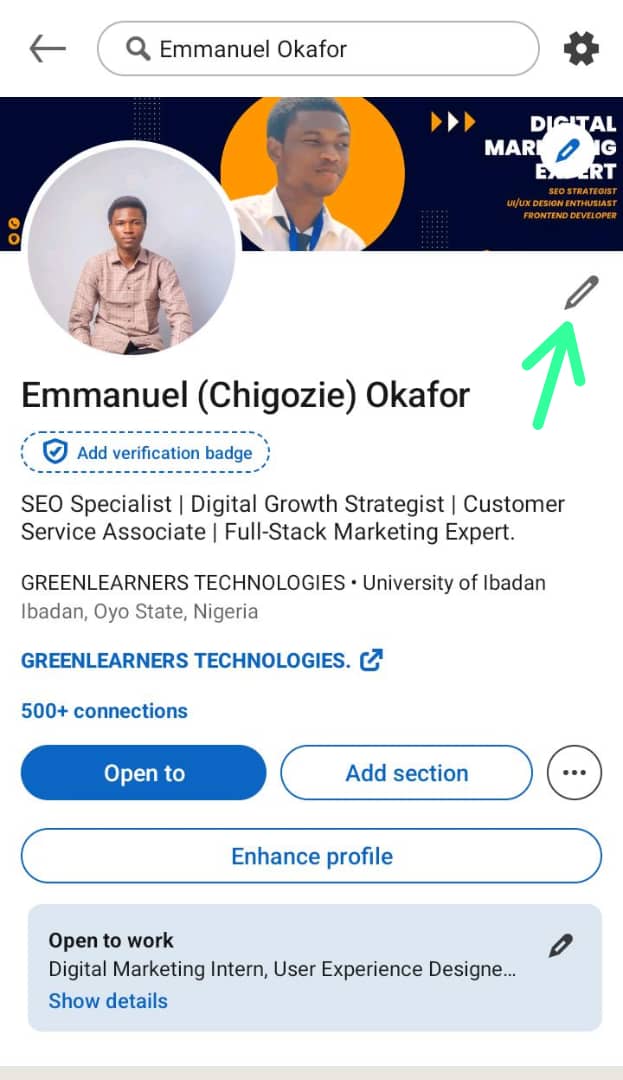
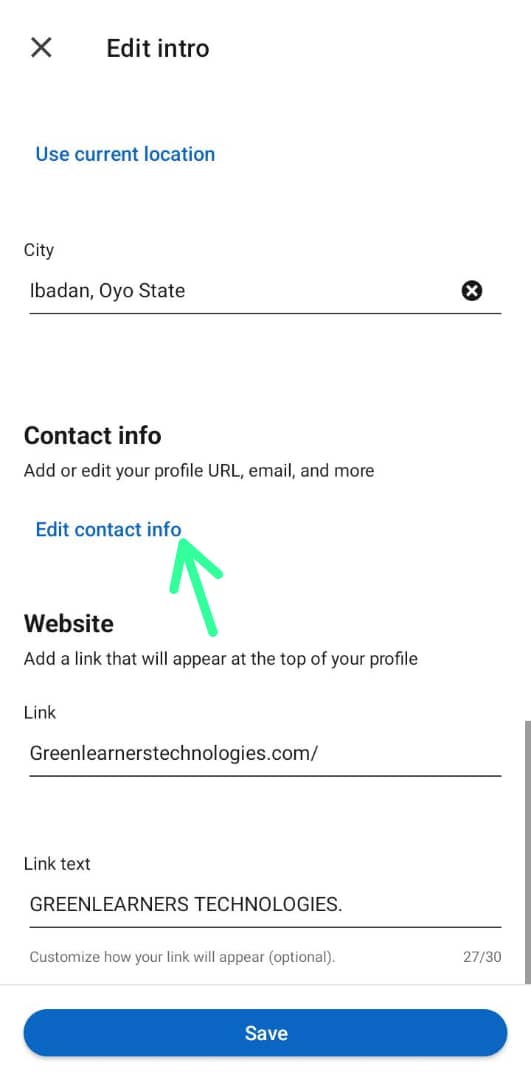


Revamping Your LinkedIn Account for Maximum Impact
Now here’s where things get real. Having an account is one thing; having an account that actually attracts recruiters and opportunities is something else entirely. This is where you transform your LinkedIn presence from invisible to unmissable.
If you are looking for a professional who can help you revamp your LinkedIn profile, the ⇒ REVAMP LINKEDIN PROFILE HERE
Craft a Headline That Actually Says Something
Your headline is prime real estate. Most people list their job title: “Marketing Manager” or “Software Engineer.” Yawn. That’s not going to cut it.
Here’s the difference:
Generic: “Product Manager at Tech Company”
Strategic: “SEO Specialist | Digital Growth Strategist | Customer Service Associate | Full-Stack Marketing Expert”

See the difference? Your headline should include:
- Your current role
- Key skills that match what recruiters are actually searching for
- A value proposition (what you actually do for people)
- A hint of your personality
When you’re crafting your headline for LinkedIn posts to share your journey and attract offers, remember this: you’re competing for attention with over 900 million other professionals. Make your headline count.
Write an About Section That Tells Your Story
Your About section is your chance actually to connect with people. This is where you tell your professional story in a way that feels human.
Structure it like this:
Hook: Start with why you do what you do. Not “I’m a data analyst.” More like “I turn messy data into actionable insights that drive real business growth.”
Career Journey: Provide a brief narrative of how you got to where you are now. What were your beginning steps? How many twists and changes were in your path? In the process, what did you learn?
Current Focus: What are you genuinely passionate about right now?
Call to Action: How do you want people to engage with you? “Let’s connect if you’re interested in growth marketing strategies”, or “Happy to chat about the future of remote work.”
Keep it between 3-5 short paragraphs, use bullet points for key achievements, and absolutely use relevant keywords that match the roles you’re targeting.
Keyword Optimization: The Secret Sauce
Remember when SEO was just for websites? That is now old-fashioned. Welcome to 2025, where LinkedIn operates on similar principles. Recruiters use search filters to find professionals with specific skills and keywords that match their requirements. If those keywords aren’t all over your profile, you’re invisible to them.
Research the job descriptions for roles you’re targeting. Look for recurring words and phrases. Then use them naturally throughout your:
- Headline
- About section
- Job titles (you can edit previous job titles to reflect what you actually did)
- Skills section
Pro tip: Pin your top 3 skills. Ask colleagues and former teammates to endorse them. This signals expertise and improves your search ranking.
Experience Section: Show, Don’t Just Tell
Your experience section isn’t a list of responsibilities. It’s evidence of your impact. For each role, go beyond generic descriptions and highlight concrete results.
Instead of: “Managed social media accounts”
Write: “Grew social media following from 50K to 250K in 18 months by implementing a community-first content strategy, increasing monthly engagement by 300%.”
See what happened there? Numbers, context, and actual impact.
How to Use LinkedIn Posts to Share Your Journey & Attract Offers
Alright, I think your profile is solid. Now, let’s discuss the actual content. This is where things get exciting, because LinkedIn posts to share your journey and attract offers become your secret weapon.
Why Storytelling Beats Everything Else
Here’s something that blew my mind when I first learned it: posts written as stories receive 22 times more engagement than purely informational content. Not 2 times. Not 5 times. 22 times.
Think about it. Your LinkedIn feed gets a lot of corporate jargon, listicles, and general advice, but what is a true story? A person telling about a real hardship that they went through, how they conquered it, and what lesson they learned? That gets through all the racket.
When you use LinkedIn posts to share your journey and attract offers, you’re not just broadcasting information. You’re building trust. You’re showing vulnerability. You’re being human. And do you know who pays attention to that? Recruiters. Hiring managers. People with actual job opportunities.
Here’s the framework I recommend for structuring your posts:
Hook: Start with a question, surprising statement, or relatable moment that makes people stop scrolling.
Situation: Paint the picture. What was happening? What was the challenge or opportunity?
Challenge: What made this difficult? What were you struggling with? What did you not know?
Resolution: How did you overcome it? What did you try? What worked?
Lesson: What did you learn? How has this changed your approach? Why should your audience care?
Call to Action: End with something that invites engagement. Ask a question. Share what you’re curious about. Keep it conversational.
Examples of Posts That Actually Work
Career Pivot Story:
“Six months ago, I was comfortable in my product management role. But comfortable wasn’t feeding my soul anymore. I’d always been fascinated by the operations side, how do you actually scale a company? So I took a risk. I asked for a lateral move into ops, accepted a pay cut, and basically started over.
Here’s what nobody tells you about career pivots: the first few months feel like learning to walk again. I was copying processes from our Notion wiki. I was asking ‘dumb’ questions in meetings. I was doubting myself constantly.
However, it was what changed my perspective: my team didn’t judge me. Instead, they invested in me. They explained the context. They answered questions patiently. And slowly, things started clicking.
Three months in, I helped us reduce onboarding time from six weeks to three weeks. Not because I was more intelligent than the previous operations person, but because I brought a product mindset to the problem.
The lesson? Your next role doesn’t require you to know everything already. It requires you to commit to learning fast and staying humble.
Are you thinking about a significant career change? What’s holding you back?
#CareerPivot #OperationsManagement #CareerGrowth”
Why this works: It’s vulnerable. It shows struggle. It ends with a concrete win. And it invites your network to engage.
Learning in Public:
“I spent three hours yesterday debugging a production issue I created myself. Yeah, I shipped code to production without proper testing, and everything went down for 45 minutes.
Embarrassing? Absolutely. Did I want to hide under my desk? You bet.
But here’s what happened next: instead of panicking, our team rallied. We communicated transparently with customers. We fixed it. We learned from it.
And I learned something about myself: the fear of making mistakes is way worse than making them and actually recovering.
The best engineers aren’t the ones who never fail. They’re the ones who fail fast, learn faster, and keep shipping.
If you’ve made a memorable mistake that taught you a valuable lesson, I’d love to hear about it.
#LearningJourney #FailuresAndLessons #Engineering”
Why this works: It demonstrates vulnerability and growth. It positions you as someone who learns from mistakes. It’s relatable to almost everyone.
The Magic of Consistent Posting
Here’s something the algorithm gods have revealed: consistency beats perfection every single time. LinkedIn in 2025 has shifted to reward expertise and valuable content 2.3 times better than generic engagement-bait posts. But that expertise only shows up when you’re consistently posting about your area of focus.
You can start with a realistic schedule. For most professionals building their personal brand, posting two to three times per week is the sweet spot. It’s enough to stay visible, but not so much that you’re burning yourself out.
Pro tip: LinkedIn’s algorithm gives posts a “golden hour”—the first hour after you publish. During this time, your post is shown to a small sample of your network, and LinkedIn is watching to see if people engage. If they do, your post gets wider distribution. So if possible, publish when your network is active and likely to engage quickly.
Mix Up Your Content Types
Variety keeps your audience interested and signals to the algorithm that you’re a well-rounded professional. Here’s a content mix that works:
Value posts (60%): Tips, frameworks, lessons learned, how-to content. Teach something useful.
Story posts (20%): Personal or professional narratives. Challenges you’ve overcome. Career pivots. Lessons from failure.
Engagement posts (15%): Questions, polls, controversial takes (thoughtfully). Get people talking.
Behind-the-scenes (5%): Day-in-the-life, team celebrations, company culture moments. Show your humanity.
When you’re consistently sharing content across these categories, you’re not just making noise. You’re building authority. You’re showing depth. You’re becoming someone people want to follow.
The Power of Vulnerable, Authentic Content
Let me be direct here: nobody gets excited about perfect. Perfect is boring. Perfect is forgettable. What moves people, what actually makes recruiters take notice, is authenticity.
The best content I’ve seen on LinkedIn comes from professionals willing to share:
- Moments they felt out of their depth
- Mistakes they made and what they learned
- Times they changed course
- Struggles with imposter syndrome
- Questions they’re genuinely wrestling with
When you share this kind of content, something magical happens. People comment with their own experiences. Conversations deepen. And guess what? Recruiters and hiring managers are in those comments, noticing you.
Here’s the truth about using LinkedIn posts to share your journey and attract offers: recruiters aren’t just looking for perfect candidates. They’re looking for people who are growing, learning, and genuinely engaging with their industry. Vulnerability signals growth. It signals confidence. It signals humanity.
The LinkedIn Algorithm: What Actually Gets Seen in 2025
Alright, you’re posting consistently. You’re being authentic. But here’s a question I get all the time: “Why aren’t my posts getting more engagement?”
Welcome to the LinkedIn algorithm. It’s not some magical black box. It actually works in a pretty transparent way once you understand the rules.
How LinkedIn Decides What to Show
LinkedIn’s algorithm works in three main steps:
Quality Filtering: Your post gets evaluated for spam, low quality, or high quality. If it passes, you’re in the game.
Engagement Testing: LinkedIn displays your post to a sample of your immediate network and monitors the response within the first hour. Are people engaging? Do they spend time reading it? Do they comment? This “golden hour” determines everything.
Network and Relevance Ranking: If your post passes engagement testing, it gets distributed more widely to people in your extended network based on three factors: identity (who they are), content (how relevant your topic is to them), and member activity (what they typically engage with).
What Actually Works
LinkedIn’s 2025 algorithm rewards:
Expertise: If you consistently post about one niche, LinkedIn identifies you as an expert and shares your content more widely. So if you’re a product manager, don’t randomly post about cryptocurrency. Please stay in your lane and own it.
Original Insights: Are we talking about generic industry news? LinkedIn buries the life out of it. However, one of the unique aspects is that some data-based insights, or how prospective data on actions and outcomes, get into the hands of various stakeholders.
Dwell Time: How long do people spend reading your post? LinkedIn tracks this. Long-form content that keeps people’s attention ranks higher.
Engagement Quality: Not all engagement is equal. Thoughtful comments that spark discussion are weighted higher than lazy emoji reactions.
First-Degree Connections: LinkedIn now prioritizes content from people in your immediate network. So you can invest in building genuine relationships.
Here’s the practical application: when you’re using LinkedIn posts to share your journey and attract offers, focus on creating content that’s genuinely valuable to your specific audience. Not viral. Not flashy. Valuable.
Engagement: How to Build Relationships That Lead to Opportunities
Here’s something recruiters told me over and over: they notice who’s actually engaging on the platform, not just broadcasting their presence.
The Art of Strategic Commenting
When you see a post from someone in your network or industry, don’t just like it; engage with it. Please feel free to share your thoughts.
Instead of: “Great post!”
Try: “This resonates with my experience leading distributed teams. I’d add that the biggest challenge we faced wasn’t the time zone differences, but rather the documentation. Teams that documented decisions asynchronously saw 40% fewer miscommunications. Have you found that in your work?”
See what’s happening? You’re adding value. You’re showing you’ve thought deeply about the topic. You’re inviting further conversation. And your name is now visible to everyone who reads that thread, including recruiters.
Building Genuine Connections
Remember when I said LinkedIn isn’t just a platform; it’s a relationship-building engine? This is where that really matters.
When you want to connect with someone new, personalize your request to make a lasting impression. Reference something specific, a post they wrote, a company they work for, or a shared interest.
“Hi [Name], I saw your post on remote team culture and loved your perspective on asynchronous communication. I’m also building distributed teams and would love to connect and exchange ideas.”
Compare that to the default message, and you see why personalization matters. It shows you’ve actually engaged with their work.
Pro tip: Connect strategically with hiring managers and recruiters in your target companies and industries. Follow their content. Engage with what they post. When you eventually reach out or when a relevant opportunity opens up, you’re not a cold connection; you’re someone they’ve noticed.
The “Open to Work” Strategy
LinkedIn has a feature called “Open to Work” where you can signal that you’re looking for opportunities. Here’s the thing: using it doesn’t make you look desperate. It makes you look proactive.
Please activate it, specify your target job titles, locations, and employment types (e.g., full-time, part-time, contract), and make sure that only recruiters can view it if privacy is a concern.
Then, it is critical to combine this with strategic content. Post about your growth. Share insights from your industry. Engage in conversations. You’re basically saying to recruiters: “I’m available, I’m active, I’m valuable, and I’m exactly the kind of professional you should be talking to.”
How Recruiters Actually Use LinkedIn to Find Talent
This is the information they typically don’t cover in career guides. Still, it’s absolutely crucial to understand how to effectively use LinkedIn posts to share your journey and attract job offers.
Recruiters aren’t passively scrolling your profile. They’re actively searching. They’re using filters for specific skills, industries, experience levels, and locations. They’re looking at who engages with content about their company or industry.
Here’s their actual workflow:
This is a very crucial aspect. Recruiters look at your recent activity. Is your posting? Could you let me know if you are engaging? Are you learning and developing? A persona that is fully formed but has no activity? This is overlooked in favour of an active profile with constant engagement. It sends out a message of vigour. It sends out a message of expansion. It conveys a message of a person who is up-to-date in their field. That is the reason why regular and genuine content is not seen as vanity. It is making you more attractive to recruiters.
Real Talk: What Nobody Tells You About Personal Branding on LinkedIn
Before I conclude, I’d like to share some hard truths I’ve learned after working in tech for over five years.
First: Not every post will go viral. That’s okay. You’re not trying to go viral. You’re trying to build relationships with people who matter to your career. Sometimes that’s a post with 30 comments from your ideal audience. That’s worth more than 10,000 likes from random people.
Second: Your LinkedIn presence should reflect who you actually are. I’ve seen professionals create these polished, corporate personas, and it comes across as inauthentic. People connect with real humans, not brand robots. Show personality. Use your voice. Let your quirks show.
Third: Building an audience takes time. I know everyone wants instant results. But think of LinkedIn as a long-term investment in your career. Post consistently for three months, and you’ll start noticing differences. Six months in, opportunities begin to appear. A year in, you might be genuinely surprised by what LinkedIn has built for you.
Fourth: The goal isn’t followers; it’s genuine connections and opportunities. I’d take 500 highly engaged followers in my industry over 50,000 random followers any day. Quality over quantity, always.
Making It All Work Together: Your 30-Day Action Plan.
Okay, so you’re excited. You understand why LinkedIn posts to share your journey and attract offers matter. Now, how do you actually start?
For one-on-one mentorship on how to fully optimize your LinkedIn profile, reach out to us here ⇔ : LINKEDIN OPTIMIZATION
Here’s what I recommend:
Week 1 – Optimize Your Foundation:
- Update your profile photo and headline
- Rewrite your About section with your actual story
- Add relevant keywords throughout your profile
- Customize your URL
- Fill in the Skills section and ask three colleagues to endorse your top skills
Week 2 – Set Up for Visibility:
- Activate “Open to Work” if you’re job hunting
- Identify three people in your target roles or companies and follow them
- Engage with five posts from people in your industry (thoughtful comments, not just likes)
- Plan your first three posts using the storytelling framework I shared
Week 3 & 4 – Build Momentum:
- Post twice per week (at least)
- Engage with ten posts per week from your network
- Personalize and send five connection requests
- Reply to every comment on your posts with genuine engagement
After 30 days, could you review what’s working? Which posts got the most engagement? What topics resonated? Could you double down on those patterns?
The Bottom Line
Using LinkedIn posts to share your journey and attract offers isn’t about being the loudest voice in the room. It’s about being the most authentic, valuable, and consistent presence.
It’s about showing up genuinely, sharing authentic experiences, and building genuine relationships. And yes, making yourself visible to the opportunities and people who matter.
I’ve watched this strategy transform careers. People who were invisible on LinkedIn six months ago are now getting inbound recruiting messages, interview requests, and unexpected partnership offers. Not because they’re more talented than anyone else, but because they intentionally built their visibility.
Your journey is unique. Your insights are valuable. Your experiences matter. The world deserves to know about them.
So start today. Update that profile. Write that first post. Engage authentically. The recruiter who changes your career is literally waiting to find you. You have to be visible.
Key Action Items for Using LinkedIn Posts to Share Your Journey & Attract Offers
- Complete all 10 profile optimization steps this week
- Draft your first three authentic posts using the storytelling framework
- Post consistently: minimum 2-3 times per week
- Engage genuinely with at least 10 posts per week
- Activate “Open to Work” and combine with strategic content
- Focus on expertise, original insights, and authentic storytelling
- Build genuine relationships through personalised outreach
- Track what works and double down on high-performing content
Call to Action
Are you ready to transform your LinkedIn presence and start attracting opportunities? Here’s how Gabata can help:
At Gabata, we specialize in building authentic professional brands that actually move the needle. Whether you’re struggling to figure out your personal brand, unsure how to tell your story compellingly, or ready to take your LinkedIn presence to the next level, we’ve got you covered.
Our LinkedIn personal branding coaching helps you identify your unique value proposition, craft posts that resonate with your audience, and build genuine relationships that lead to real opportunities.
Start today: Take the 30-day action plan in this article and commit to it. Post consistently. Engage authentically. Share your journey. Watch what happens.
Still feeling stuck? Let us guide you. We’ve helped hundreds of professionals transform from invisible to irresistible on LinkedIn. Your next opportunity is waiting- you need to be visible.

